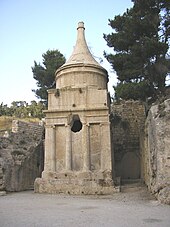Rock-cut architecture
Rock-cut architecture is the creation of structures, buildings, and sculptures by excavating solid
).A related term,
Some rock-cut architecture is excavated entirely in chambers under the surface of relatively level rock. This is especially common in

History
Ancient monuments of rock-cut architecture are widespread in several regions of world. A small number of Neolithic tombs in Europe, such as the c. 3,000 B.C. Dwarfie Stane on the Orkney island of Hoy, were cut directly from the rock, rather than constructed from stone blocks.
Alteration of naturally formed caverns, although distinct from completely carved structures in the strict sense, date back to the neolithic period on several Mediterranean islands e.g.
During the
In the 8th century, the
In the 5th century BCE, the

The creation of rock-cut tombs in ancient Israel began in the 8th-century BCE and continued through the Byzantine period. The Tomb of Absalom was constructed in the 1st century CE in the Kidron Valley of Jerusalem.
Rock-cut architecture occupies a particularly important place in the history of Indian Architecture. The earliest instances of
Artisans in the

The technological skills associated with making these complex structures moved into China along the trade routes. The Longmen Grottoes, the Mogao Caves, and the Yungang Grottoes consist of hundreds of caves many with statues of Buddha in them. Most were built between 460 and 525 CE. There are extensive rock-cut buildings, including houses and churches in Cappadocia, Turkey.[12] They were built over a span of hundreds of years prior to the 5th century CE. Emphasis here was more on the interiors than the exteriors.

Another extensive site of rock-cut architecture is in Lalibela, a town in northern Ethiopia. The area contains numerous Orthodox churches in three dimensions, as at Ellora, that were carved out of the rock. These structures, which date from the 12th and 13th centuries CE and which are the last significant examples of this architectural form, ranks as among the most magnificent examples of rock-cut architecture in the world, with both interior and exterior brought to fruition.[citation needed]
Art
Ancient rock cut tombs, temples and monasteries often have been adorned with frescoes and reliefs. The high resistance of natural cliff, skilled use of plaster and constant microclimate often have helped to preserve this art in better condition than in conventional buildings. Such exceptional examples are the ancient and early medieval frescoes in such locations as


Chronology
- Egyptian rock-cut tombs (1450 BCE, Thebes, Egypt).[6]
- Hittite rock-cut sanctuaries (1250 BCE).[6]
- Etruscan rock-cut tombs, Etruria, Italy (500 BCE).[6]
- Tomb of Darius I (Naqsh-e Rostam (480 BCE).[6]
- Lycian rock-cut tombs (4th century BCE).[6]
- Udayagiri and Khandagiri Caves, India (2nd century BCE).[citation needed]
- Buddhist caves, Western Ghats, India (100 BCE).[6]
- Petra, Jordan (100 CE).[6]
- Buddhist caves, Northwestern India (100 CE).[6]
- Houses, Tiermes, Spain (100 CE)
- Buddhist caves, Dunhuang, China (400 CE).[6]
- Buddhist caves, Ajanta, India (480 CE).[6]
- Hindu temple, Elephanta, India (600 CE).[6]
- Hindu temple, Southern India (650–750 CE).[6]
- Hindu, Buddhist and Jain caves,
- Churches,
- Churches, Lalibela, Ethiopia (1000 CE).[6]
See also
- Cliff dwelling
- Rock-cut architecture of Cappadocia
- Monolithic church – Church made up of single block of stone
- Dugout (shelter) – Hole or depression used as shelter
- Yaodong – Form of Earth Shelter Dwelling in the Loess Plateau
- List of cave monasteries
- Ostrog Monastery – Serbian Orthodox monastery on Ostroška Greda, Montenegro
- Degua Tembien– District in Tigray Region, Ethiopia, Ethiopia
- Thamud – Tribal confederation in pre-Islamic Arabia
- List of archaeological sites by country
- List of colossal sculpture in situ
- List of largest monoliths
- Indian rock-cut architecture – The creation of structures, buildings, and sculptures by excavating solid rock
- List of rock-cut temples in India
- Megalith
- Rock-cut tomb – Tomb cut out in rock
- Naqsh-e Rustam– Ancient necropolis in Fars Province, Iran
- Kandovan, Osku – village in Osku County, Iran
- Stone sculpture
- Underground construction
References
- ^ Francis Ching, Mark Jarzombek, Vikramaditya Prakash, A Global History of Architecture (Wiley, 2006)
- ^ Statue of Gomateswara
- ^ World's biggest monolithic Statue
- ISBN 978-0-313-32501-4.
- ^ Aidan Dodson. Egyptian Rock-Cut Tombs. Shire Publications 1999.
- ^ ISBN 978-1118007396.
- ^ ISBN 9780520919686.
- ^ Lycian tombs
- ^ S. Nagaraju Buddhist Architecture of Western India, c. 250 BC – AD 300 (Agam Kala Prakashan, 1981)
- ^ Vidya Dehejia, Early Buddhist Rock Temples; a Chronology. (Cornell University Press, 1972)
- ^ Rababeh, Shaher M. Rababeh, "How Petra was Built: an Analysis of the Construction Techniques of the Nabataean Freestanding Buildings and Rock-cut Monuments in Petra, Jordan" (Oxford, England: Archaeopress), 2005.
- ^ Spiro Kostof, Caves of God: the Monastic Environment of Byzantine Cappadocia (MIT Press, 1972). Vidya Dehejia, (Cornell University Press, 1972)
- Burgess, James and Fergusson J. Cave Temples of India. (London: W.H. Allen & Co., 1880. Delhi: Munshiram Manohar Lal Publishers Pvt Ltd., Delhi, 2005).[ISBN missing]


